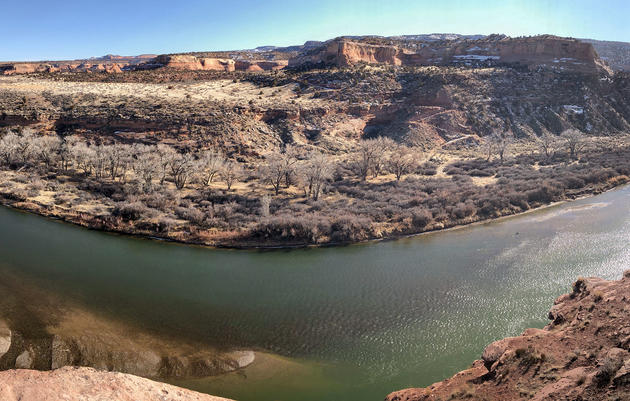Audubon Rockies is a Water for Colorado coalition partner.
As humans on this planet we are having a shared experience through the coronavirus pandemic. Our lives are connected by how this virus has altered our daily lives, mentally and physically. Hidden among the headlines is another shared experience: we are bound by water. Water from healthy rivers is vital now more than ever for hygiene, health, and economic recovery, and in the arid West, water is our most valuable resource.
Healthy, flowing rivers and waterways are also big business. In Colorado alone, Business for Water Stewardship reports statewide water-based recreation generates $18.8 billion annually, and supports more than 131,000 jobs. And that’s just looking at recreation and recreation-related activities. Healthy waterways make for vibrant economies and resilient communities by supporting birds and other wildlife, powering jobs, and fueling growth across states and around the country.
Our relationship to water is extraordinary. Water drives the lifecycles and productivity of people, birds, and other wildlife. Look to Colorado’s snowpack on mountains and mesas and you are looking at an area’s near-term water supply. As snowpack melts into runoff, western Colorado’s sandstone canyons funnel the Colorado River’s flow, a lifeline to some 400 species of birds, other wildlife, seven U.S. states, 29 federally recognized Native American Tribes, more than five million acres of irrigated farmland, 40+ million people, and two countries, and forms the foundation of a $1.4 trillion regional economy. Every drop of this river is used and reused until the Colorado literally dries up, miles before it reaches its connection with the sea. The value of the Colorado River extends far beyond its geographic watershed.
However, water across the Colorado River basin is not as predictable as it once was. For the last 20 years, we are living in a warming and drying landscape. A recent study reveals that a “megadrought” appears to be emerging in the western United States. Scientists are telling us that, due in part to human-caused climate change, we are heading into a drought that is more intense than modern society has seen.
In a recent report, Brad Udall, senior water and climate research scientist at the Colorado Water Institute wrote, “…we now know with high confidence that continued emissions of greenhouse gases into the atmosphere guarantee continued warming and that this continued warming makes more widespread, prolonged, and severe dry spells and drought almost a sure bet. This translates into an increasingly arid Southwest and West, with progressively lower river flows, drier landscapes, higher forest mortality, and more severe and widespread wildfires—not year on year, but instead a clear longer-term trend toward greater aridification, a trend that only climate action can stop.”
Over the last three years, Coloradans have seen firsthand snowpack and water extremes. In water year 2018 (a water year starts on October 1 of the previous calendar year), Colorado experienced one of the driest years on record. Then, 2019 was one of the all-time wettest. For the first time in 20 years Colorado was completely drought-free–for a short time. 2019 ended with a hot dry summer and fall, depleting soil moistures shepherding drought conditions back into our reality. In 2020, strong snowpack built early, but a warm, dry spring induced a snowpack freefall and caused early melt and peak runoff. Coupled with thirsty soils from the year before, May 2020 saw most of Colorado’s rivers flowing below average and more than 1.6 million Coloradans living in drought or abnormally dry conditions. In the southwestern corner of the state, low flows and wildfire risk are growing fears.
Worry is building. Water and climate change forecasts are concerning and water leaders need to take immediate steps to avoid the very real possibility of water shortages for both people and the environment. Colorado's Water Plan, finalized in 2015, provides guidance for water resource use toward a more sustainable water future. The plan aims to ensure a sufficient supply of water for the various users across the state, including environmental, agricultural, municipal, industrial, and recreational needs. Colorado’s Water Plan is a roadmap with measurable outcomes and goals to ensure that Colorado and its environment have a more secure water future.
"The CWCB [Colorado Water Conservation Board] is committed to supporting our water users and stakeholders from across all sectors and all parts of the state. Since the Water Plan was first published in 2015, our staff has worked with partners to improve data and tools needed to meet our state goals while addressing various future conditions environmentally, economically, and socially," said Colorado Water Conservation Board Director Rebecca Mitchell. “We are now working to incorporate these updates as well as goals from the nine Basin Implementation Plans into a new and improved version of the Colorado Water Plan, set for release in 2022."
But having a plan is only as good as its implementation. The Water Plan calls for funding needs of $100 million annually starting this year and continuing through 2050, but that amount of funding is unlikely to materialize, in part due to looming budget and revenue shortfalls. The economic downturn from the coronavirus pandemic means Colorado faces a $6.8 billion hit to the state budget in coming years. Legislators have the immediate challenge of deciding how to cut as much as $3.1 billion in state spending, an unprecedented 25 percent budget reduction. Many cuts are critical services for every Coloradan.
Even in these dire economic and drought-permeated times, funding for Colorado’s Water Plan must be a priority. When we understand the connections—where our water comes from and how much we depend upon it—then we value water for what it is: life and prosperity. The future of Colorado is dependent on water and each of us are connected by it. Now is the time to support healthy, flowing rivers and waterways for physical and economic recovery. Now is the time to invest in our water resiliency, stability, and sustainability.










